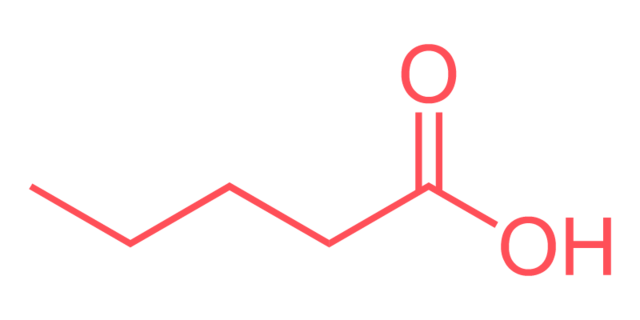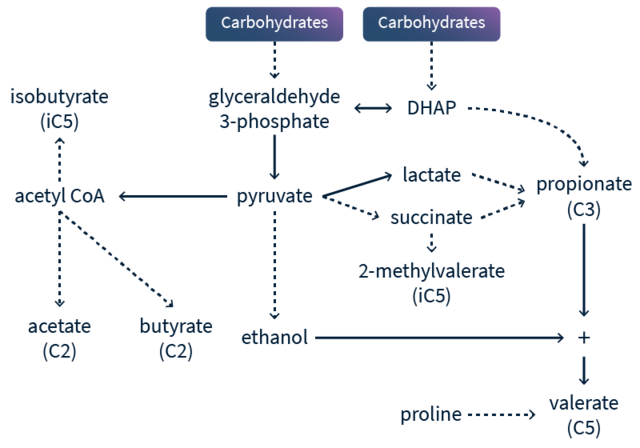Valeric Acid

Linear Formula
CH3(CH2)3COOH
Synonyms
n-Valeric acid
Pentanoic acid
Share this metabolite
Valeric Acid Overview
Valeric acid, or pentanoic acid, is a short-chain fatty acid (SCFA). SCFAs, such as valeric acid and acetic acid (vinegar), are carboxylic acids with short aliphatic tails. Valeric acid can be extracted from the root of the perennial flowering plant valerian (Valeriana officinalis). It can also be produced by some bacterial species in the gut microbiota, such as Clostridia and Megasphaera massiliensis.1 This process occurs through the anaerobic fermentation of carbon sources found in indigestible foods.

Valeric Acid and Gastrointestinal Health
Valeric acid is one of the many energy sources of intestinal microbiota, making them crucial to gastrointestinal (GI) health. Valeric acid exerts strong GI protective effects. A study involving mice that received high doses of radiation showed that valeric acid supplementation increased the survival rate of irradiated mice, improved GI health, and enhanced tissue integrity.2
Valeric Acid and Neuroscience
Valeric acid can also modulate brain function; it was recently shown to play a role in the initiation and progression of Alzheimer’s disease (AD). Multiple studies have reported alterations in the gut microbiome composition of AD patients compared to healthy individuals. One potential mechanism is through the production of SCFAs in the gut. A study showed that valeric acid and acetic acid, two SCFAs, increased the expression of pro-inflammatory cytokines and endothelial damage in the brain. An increase in these two SCFAs compromised the integrity of the blood-tissue barrier, caused low-grade systemic inflammation, and facilitated the AD pathological cascade.3 Therefore, interventions that modulate the gut microbiome and promote beneficial bacteria and bacterial metabolites may be useful in preventing, slowing down, or ameliorating neurodegeneration in AD.
Valeric Acid and Cosmetics
Industrially, valeric acid is mainly used in the synthesis of its esters. Esters are organic compounds that are formed by the reaction between an alcohol and a carboxylic acid. This reaction is known as esterification. Esters of valeric acid are known as valerates. Valerates tend to have pleasant odors and are used in perfumes and cosmetics. Some valerates are used as food additives because of their fruity flavors.4
Valeric Acid and Drug Development
Valeric acid’s esters (valerates) are also often used in pharmaceuticals. Valerates are often combined with certain steroid drugs to increase their solubility and improve their absorption into the body. For example, one common steroid-based pharmaceutical that uses valerate is betamethasone valerate, which is used to treat a variety of inflammatory and allergic conditions, such as eczema and psoriasis. Another example is estradiol valerate, which is a form of estrogen used in hormone replacement therapy. Adding valerate to these steroid drugs helps improve their stability and enhance their therapeutic effects. Overall, valeric acid is an important component of many steroid-based pharmaceuticals, helping to improve their solubility and effectiveness, enabling them to better treat a range of medical conditions.
References
- Yuille S, Reichardt N, Panda S, Dunbar H, Mulder IE. Human gut bacteria as potent class I histone deacetylase inhibitors in vitro through production of butyric acid and valeric acid. PLoS One. 2018;13(7):e0201073. doi:10.1371/journal.pone.0201073
- Li Y, Dong J, Xiao H, et al. Gut commensal derived-valeric acid protects against radiation injuries. Gut Microbes. Jul 03 2020;11(4):789-806. doi:10.1080/19490976.2019.1709387
- Marizzoni M, Cattaneo A, Mirabelli P, et al. Short-Chain Fatty Acids and Lipopolysaccharide as Mediators Between Gut Dysbiosis and Amyloid Pathology in Alzheimer’s Disease. J Alzheimers Dis. 2020;78(2):683-697. doi:10.3233/JAD-200306
- Ganigué R, Naert P, Candry P, de Smedt J, Stevens CV, Rabaey K. Fruity flavors from waste: A novel process to upgrade crude glycerol to ethyl valerate. Bioresour Technol. Oct 2019;289:121574. doi:10.1016/j.biortech.2019.121574

